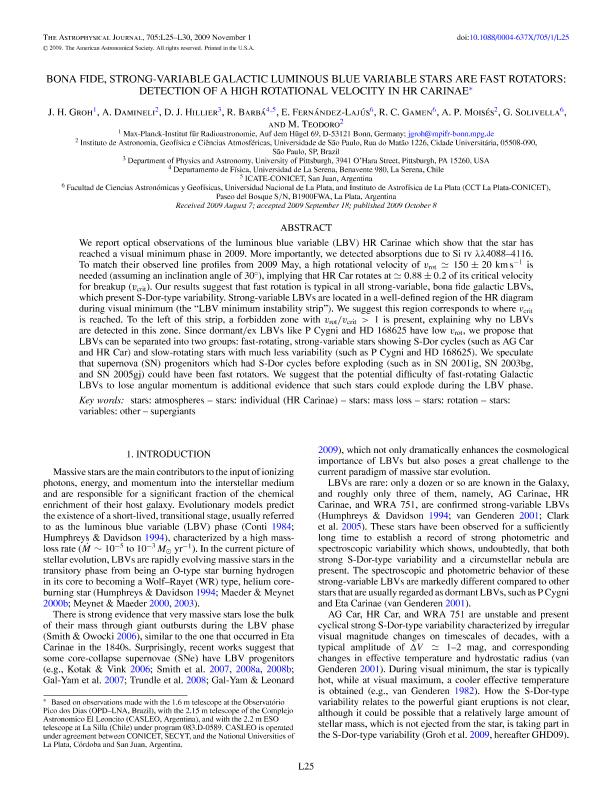Mostrar el registro sencillo del ítem
dc.contributor.author
Groh, J. H.
dc.contributor.author
Damineli, A.
dc.contributor.author
Hillier, D. J.
dc.contributor.author
Barba, Rodolfo Hector

dc.contributor.author
Fernandez Lajus, Eduardo Eusebio

dc.contributor.author
Gamen, Roberto Claudio

dc.contributor.author
Moisés, A. P.
dc.contributor.author
Solivella, Gladys Rebeca

dc.contributor.author
Teodoro, M.
dc.date.available
2018-04-23T14:11:46Z
dc.date.issued
2009-12
dc.identifier.citation
Groh, J. H.; Damineli, A.; Hillier, D. J.; Barba, Rodolfo Hector; Fernandez Lajus, Eduardo Eusebio; et al.; Bona-fide, strong-variable galactic Luminous Blue Variable stars are fast rotators: detection of a high rotational velocity in HR Carinae; IOP Publishing; Astrophysical Journal; 705; 12-2009; 25-30
dc.identifier.issn
0004-637X
dc.identifier.uri
http://hdl.handle.net/11336/42988
dc.description.abstract
We report optical observations of the Luminous Blue Variable (LBV) HR Carinae which show that the star has reached a visual minimum phase in 2009. More importantly, we detected absorptions due to Si IV 4088-4116 Angstroms. To match their observed line profiles from 2009 May, a high rotational velocity of vrot=150 +- 20 km/s is needed (assuming an inclination angle of 30 degrees), implying that HR Car rotates at ~0.88 +- 0.2 of its critical velocity for break-up (vcrit). Our results suggest that fast rotation is typical in all strong-variable, bona-fide galactic LBVs, which present S Dor-type variability. Strong-variable LBVs are located in a well-defined region of the HR diagram during visual minimum (the "LBV minimum instability strip"). We suggest this region corresponds to where vcrit is reached. To the left of this strip, a forbidden zone with vrot/vcrit>1 is present, explaining why no LBVs are detected in this zone. Since dormant/ex LBVs like P Cygni and HD 168625 have low vrot, we propose that LBVs can be separated in two groups: fast-rotating, strong-variable stars showing S-Dor cycles (such as AG Car and HR Car) and slow-rotating stars with much less variability (such as P Cygni and HD 168625). We speculate that SN progenitors which had S-Dor cycles before exploding (such as in SN 2001ig, SN 2003bg, and SN 2005gj) could have been fast rotators. We suggest that the potential difficulty of fast-rotating Galactic LBVs to lose angular momentum is an additional evidence that such stars could explode during the LBV phase.
dc.format
application/pdf
dc.language.iso
eng
dc.publisher
IOP Publishing

dc.rights
info:eu-repo/semantics/openAccess
dc.rights.uri
https://creativecommons.org/licenses/by-nc-sa/2.5/ar/
dc.subject
Stars
dc.subject
Atmospheres
dc.subject
Hr Carinae
dc.subject
Mass Loss
dc.subject
Rotation
dc.subject
Variable Stars
dc.subject
Supergiant Stars
dc.subject.classification
Astronomía

dc.subject.classification
Ciencias Físicas

dc.subject.classification
CIENCIAS NATURALES Y EXACTAS

dc.title
Bona-fide, strong-variable galactic Luminous Blue Variable stars are fast rotators: detection of a high rotational velocity in HR Carinae
dc.type
info:eu-repo/semantics/article
dc.type
info:ar-repo/semantics/artículo
dc.type
info:eu-repo/semantics/publishedVersion
dc.date.updated
2018-04-19T18:32:16Z
dc.journal.volume
705
dc.journal.pagination
25-30
dc.journal.pais
Estados Unidos

dc.description.fil
Fil: Groh, J. H.. Max-Planck-Institut fur Radioastronomie; Alemania
dc.description.fil
Fil: Damineli, A.. Universidade de Sao Paulo; Brasil
dc.description.fil
Fil: Hillier, D. J.. Universidade de Sao Paulo; Brasil
dc.description.fil
Fil: Barba, Rodolfo Hector. Universidad de La Serena; Chile. Consejo Nacional de Investigaciones Científicas y Técnicas. Centro Científico Tecnológico Conicet - San Juan. Instituto de Ciencias Astronómicas, de la Tierra y del Espacio. Universidad Nacional de San Juan. Instituto de Ciencias Astronómicas, de la Tierra y del Espacio; Argentina
dc.description.fil
Fil: Fernandez Lajus, Eduardo Eusebio. Universidad Nacional de La Plata. Facultad de Ciencias Astronómicas y Geofísicas; Argentina. Consejo Nacional de Investigaciones Científicas y Técnicas. Centro Científico Tecnológico Conicet - La Plata. Instituto de Astrofísica La Plata. Universidad Nacional de La Plata. Facultad de Ciencias Astronómicas y Geofísicas. Instituto de Astrofísica La Plata; Argentina
dc.description.fil
Fil: Gamen, Roberto Claudio. Universidad Nacional de La Plata. Facultad de Ciencias Astronómicas y Geofísicas; Argentina. Consejo Nacional de Investigaciones Científicas y Técnicas. Centro Científico Tecnológico Conicet - La Plata. Instituto de Astrofísica La Plata. Universidad Nacional de La Plata. Facultad de Ciencias Astronómicas y Geofísicas. Instituto de Astrofísica La Plata; Argentina
dc.description.fil
Fil: Moisés, A. P.. Universidade de Sao Paulo; Brasil
dc.description.fil
Fil: Solivella, Gladys Rebeca. Universidad Nacional de La Plata. Facultad de Ciencias Astronómicas y Geofísicas; Argentina. Consejo Nacional de Investigaciones Científicas y Técnicas. Centro Científico Tecnológico Conicet - La Plata. Instituto de Astrofísica La Plata. Universidad Nacional de La Plata. Facultad de Ciencias Astronómicas y Geofísicas. Instituto de Astrofísica La Plata; Argentina
dc.description.fil
Fil: Teodoro, M.. Universidade de Sao Paulo; Brasil
dc.journal.title
Astrophysical Journal

dc.relation.alternativeid
info:eu-repo/semantics/altIdentifier/doi/http://dx.doi.org/10.1088/0004-637X/705/1/L25
Archivos asociados
